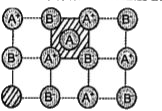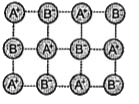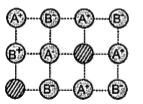When electron are trapped into the crystal in anion cancy ,the defect is known as
F-centre
Frenkel defect
Schottky defect
Interstitial defect
The correct Answer is:A
To solve the question, we need to understand the concept of defects in crystal structures, particularly focusing on the scenario where electrons occupy vacancies in the crystal lattice.
1. Understanding Crystal Defects:
- In solid-state chemistry, defects in crystals can occur due to missing atoms or ions, which can lead to vacancies. These defects can significantly affect the properties of the material.
Hint: Familiarize yourself with types of crystal defects, such as vacancies, interstitials, and substitutional defects.
2. Identifying the Type of Defect:
- The question specifically mentions "electrons trapped into the crystal in anion vacancy." This indicates that there is a missing anion (negatively charged ion) in the crystal lattice.
Hint: Recall that anion vacancies occur when an anion is missing from its lattice position, creating a vacancy.
3. Understanding F Centers:
- When an anion vacancy is created, it can be occupied by one or more electrons. These electrons are known as F centers (or color centers). F centers are responsible for the color of certain ionic crystals because they can absorb visible light.
Hint: Remember that F centers are specifically associated with anion vacancies filled by electrons.
4. Conclusion:
- Based on the understanding of F centers, we can conclude that when electrons are trapped in an anion vacancy within a crystal, the defect is referred to as an F center.
Hint: Connect the concept of F centers with their role in color absorption in crystals.
Final Answer:
The defect is known as F center.
- In solid-state chemistry, defects in crystals can occur due to missing atoms or ions, which can lead to vacancies. These defects can significantly affect the properties of the material.
- The question specifically mentions "electrons trapped into the crystal in anion vacancy." This indicates that there is a missing anion (negatively charged ion) in the crystal lattice.
- When an anion vacancy is created, it can be occupied by one or more electrons. These electrons are known as F centers (or color centers). F centers are responsible for the color of certain ionic crystals because they can absorb visible light.
- Based on the understanding of F centers, we can conclude that when electrons are trapped in an anion vacancy within a crystal, the defect is referred to as an F center.
The defect is known as F center.
Topper's Solved these Questions
- THE SOLID STATE BOOK - NCERT FINGERTPS ENGLISHCHAPTER - THE SOLID STATE EXERCISE - HOTS
7 Videos
- THE SOLID STATE BOOK - NCERT FINGERTPS ENGLISHCHAPTER - THE SOLID STATE EXERCISE - EXEMPLAR PROBLEMS
37 Videos
- THE P-BLOCK ELEMENTS BOOK - NCERT FINGERTPS ENGLISHCHAPTER - THE P-BLOCK ELEMENTS EXERCISE - Assertion And Reason
15 Videos
Similar Questions
Knowledge Check
The crystal showing Frenkel defect is:
A B
B C
C D
D
Interstitial compounds are formed when small atoms are trapped inside the crystal lattice of metals. Which of the following is not the characteristic property of interstitial compounds ?
AThey have high melting points in comparison to pure metals.BThey are very hard.CThey retain metallic conductivity.DThey are chemically very reactiveIn a solid lattice the cation and anion both have left a lattive site. The lattice defect is known as
Aintestitial defectBvancancy defectCFrenkel defectDschottky defect
How are the properties of crystal vary upon point defects?
View SolutionWhen the power of eye lens increases, the defect of vision is produced. The defect is known as
View SolutionThe photosynthetic unit to trap the light energy is known as
View SolutionFrenkel defect is also known as ……… .
View SolutionFrenkel defect is also known as ……… .
View Solution
